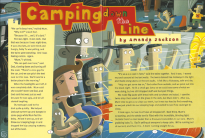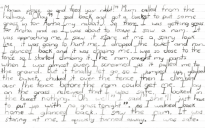You are here:
By the end of year 4

Reading
Reading
Students in year 4 are reading texts for instructional reading purposes, and they are also increasingly required to use texts to meet the demands of the curriculum as an integral part of their regular classroom programme. Students read texts in order to locate and evaluate information and ideas about a range of subjects as they generate and answer questions to meet specific learning purposes.
By the end of year 4, students use their reading processing and comprehension strategies to read texts appropriate to this level accurately and fluently. They use and integrate a variety of comprehension strategies in order to understand, respond to, and think critically about these texts.
When students at this level read, respond to, and think critically about texts, they:
- have a strong sense of what they like to read as well as what they are able to read, and they know where to locate such materials;
- select from a variety of strategies to monitor their reading and to use when meaning breaks down (e.g., cross-checking, rereading, using what they know about words and sentence structure, and looking for clues to confirm their predictions and inferences);
- meet their purposes for reading by employing specific comprehension strategies, such as:
- identifying and summarising main ideas (using their knowledge of text structure)
- making and justifying inferences (using information that is close by in the text)
- making connections between the text and their prior knowledge to interpret figurative language;
- read for sustained periods and sustain meaning in longer texts over time (e.g., when reading junior novels over several days);
- can discuss their responses to a variety of texts (e.g., by evaluating the effectiveness of a particular text for a particular purpose).
They draw on knowledge and skills that include:
Constructing meaning during discussion builds students’ metacognition and increases their awareness of the ways in which language is used to influence readers.
page 71
- automatically reading all high-frequency words;
- automatically selecting an appropriate decoding strategy when they encounter unknown words;
- working out the meanings of new words, using strategies such as:
- applying knowledge of the meanings of most common prefixes (e.g., over-, mis-, sub-, pre-, inter-, semi-, mid-) and most common suffixes (e.g., -ist, -ity, -ty, -ion, -able/-ible, -ness, -ment)
- using reference sources (e.g., dictionaries and thesauruses) to find the meanings of new words
- inferring word meanings from known roots and affixes (e.g., by using the known meaning of tele- and -port to infer the meaning of teleport);
- working out the meanings of unfamiliar phrases and expressions (e.g., figures of speech) by drawing on their oral language and the context;
- recognising the features and purposes of some common text types and using this knowledge to navigate and understand texts;
- using visual language features to support their understanding of the ideas and information in the text.
Reading Standards Illustrations: Illustrations of text relating to specific curriculum tasks and its reading demands can be viewed here. These illustrations are examples that show how a student is meeting the reading standards through a curriculum task.
Reading a wide variety of texts across the curriculum will enrich and extend students’ oral language.
Writing
Writing
Year 4 students create texts as part of their instructional writing programme as well as writing for a range of different purposes to meet the demands of the New Zealand Curriculum. They write in order to think about, record, and communicate experiences, ideas, and information to meet specific learning purposes.
By the end of year 4, students independently create a variety of texts in a range of print and electronic media. They understand their purposes for writing and identify suitable writing processes to meet the purposes. Where appropriate, their writing demonstrates an awareness of their audience through appropriate choice of content, language, and text form.
When students at this level create texts, they:
- select and use tools (e.g., graphic organisers) and strategies (e.g., using headings) to plan and organise ideas and information to meet their purposes for writing;
- create content that is mostly relevant to the curriculum task, covers a range of ideas, experiences, or items of information, and often includes detail and/or comment that supports the main points;
- reread their writing at various stages to check for meaning and fitness for purpose;
- revise and edit their writing for clarity, impact, and fitness for purpose, often in response to feedback;
- proofread for accuracy of spelling, grammar, and punctuation;
- make choices, when appropriate, for publishing in a variety of media, including digital and visual media.
They draw on knowledge and skills that include:
- using language and a simple text structure that are appropriate for the purpose, e.g., an orientation, sequenced events described in the past tense, and linking words to show sequence (for a recount);
-
using vocabulary (in particular, nouns, verbs, adjectives, and adverbs) that clearly conveys ideas, experiences, or information;
encoding (spelling) by:- using their knowledge of diverse phoneme–grapheme relationships (e.g., ship, chef, ocean, station, special), of the meaning and spelling of morphemes (e.g., root words and affixes), and of common, reliable spelling rules and conventions
- using their visual memory to help them spell personal vocabulary and high-frequency words correctly (the high-frequency words include most words from essential lists 1–4 and many from essential lists 5–71);
- expanding their writing vocabulary by using strategies such as:
- applying their knowledge of the meaning of most common prefixes (e.g., un-, sub-, pre-, non-) and most common suffixes (e.g., -ful, -ly, -tion, -able/-ible, and -ment)
- using reference sources (e.g., dictionaries and thesauruses) to check the meanings of words and to find new words;
- using written language features (such as similes and onomatopoeia) and visual language features (such as illustrations and diagrams) to support meaning;
- using mainly simple and compound sentences, along with some complex sentences, that vary in their beginnings, structures, and lengths and are mostly correct grammatically;
- correctly using subject–verb agreement, tense agreement, and pronouns and prepositions;
- using capital letters, full stops, question marks, and exclamation marks correctly and using speech marks, commas for lists, and apostrophes for contractions correctly most of the time.
Writing Standards Illustrations: Illustrations of students' texts provide a snapshot of the skills and strategies the students have used to meet the writing demands of the curriculum can be viewed here. These illustrations are examples that show how the student is meeting the writing standards through a curriculum task.
1. The lists of essential words are in Croft (1998). They are examples only, and teachers may refer to other reputable lists of high-frequency words.



